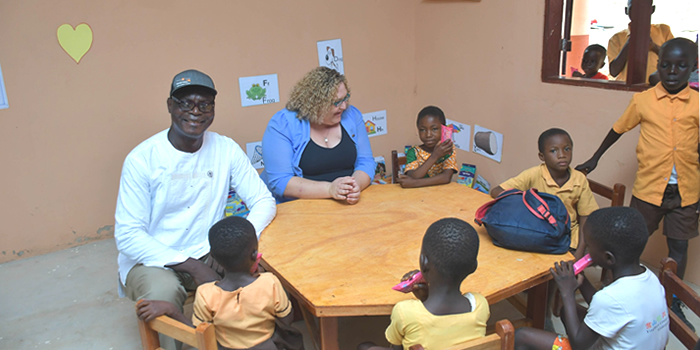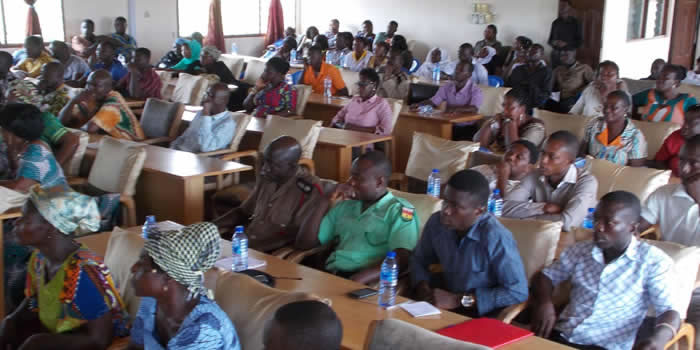

Introduction
Knowing the size and composition of population of a place is very essential for effective planning and development. It becomes a benchmark by which development of a place can be measured and a fulcrum around which developmental agenda revolves. The age and sex structure play a pivotal role in population management, policy formulation and implementation since they provide the basic information and details needed to map out developmental programs and strategies at national and local levels by governments (national and local) as well as other stakeholder institutions. The size, age and sex composition of the population as well as the fertility, mortality and migration pattern in the district are discussed in this chapter.
Population Size and Distribution
This section provides information on sex composition, sex ratio and type of locality. The total population of the district according to the 2010 PHC is 60,054, constituting 2.7 percent of the population of the Central Region. The District has the lowest proportion of the population of the region. The entire population of the district resides in rural areas and making it one of the two districts in Central Region with no urban population, that is settlements with 5,000 or more people.
Age and Sex-Structure
The age structure and the sex composition of the population of the District follow the region and the national pattern. The age structure is that of a broad base and reduces gradually in the subsequent age groups until the population becomes relatively small in the older ages.
Age specific sex ratios
The Upper Denkyira East is one of the districts in the region dominated by the male population, with 101 males to 100 females. The age specific sex ratio ranges from about 64 males for every 100 females in the older ages of 85 years and older to 118 males for every 100 females in the age group 55-59 years. There are slightly more males than females for the population below 19 years and between 40 and 59 years.
Dependency ratio
The age-dependency ratio is a theoretical concept which does not apply strictly in real population and differs from economic dependency ratio. For example although ages 15-64 are not "dependent" a large proportion of youth 15-19 are "dependent" in practice, that is being at school or not supporting anyone. Similarly, not all persons aged 65 years and over are dependent. The age-dependency ratio is often used as an indicator of the economic burden that the productive portion of a population must bear. Countries with very high birth rates coupled with low death rates usually have the highest age-dependency ratios because of the large proportion of children in the population.Table 2.1 indicates that there are variations in the dependency ratio for males and females and locality of residence. The total dependency ratio for the District is 86.8, which means that for every 100 people in the working class there are about 87 people in the dependent population to support.
Population pyramid
The age and sex structure of the Upper Denkyira East District is shown in the population pyramid (Figure 2.1). The pyramid has a relatively large base, reduces gradually in the subsequent age groups until the population becomes relatively small in the older ages. The Figure provides insightful lessons regarding current and future fertility and migration patterns to enhance policy formulation and infrastructure planning. The pyramid generally shows the expected pattern of declines in the length of the bars for each group with advancing age.
Fertility, Mortality and Migration
Fertility, mortality and migration are important in influencing population dynamics and development. Fertility and mortality are used to determine the natural increase or decrease of the population. The 2010 population and housing census collected data on fertility which is the natural capability of producing off-springs. Mortality refers to all deaths that occurred in the household during the 12 months preceding the Census Night, whiles migration refers to the physical movement of persons across geographical boundaries for a given period. This is measured by combining data on the place of birth with place of enumeration and duration of stay at place of enumeration.
Fertility
Fertility refers to the actual birth performance or childbearing among a population. The general fertility rate (GFR) is the number of births in a given year divided by the mid-year population of women in the age group 15-49. The total fertility rate (TFR) which is widely used is the average number of live births per 1,000 women in the childbearing age (15-49 years). In other words, it is the average number of children a woman would give birth to by the end of her reproductive years if current fertility rates prevailed (IUSSP, 1982). The crude birth rate indicates the number of life births occurring during a year, per 1000 population. Table 2.2 shows that the crude birth rate (CBR) 31.0 per 1,000 for the Upper Denkyira East District is the highest in the Central Region.
It means that 31 births occur for every 1000 population in the District per year compared to 27 in the region. The general fertility rate which is more refined than the CBR also shows that fertility is the highest in Upper Denkiyra East as about 135 births per 1,000 women aged 15-49 years is recorded annually compared to an average of 107 in the region. The more refined of the three indicators and the widely used, total fertility rate (TFR), is 4.5 compared to 3.6 for the region. It implies that on the average every woman in the reproductive age has between four and five children in the District compared to between three and four per woman in the region generally. This high fertility rate will require more health facilities to sustain the expanding population in the future if sustained.
Children ever born and children surviving
The 2010 PHC collected information on lifetime fertility of all women 12 years and older. In all, 58,482 children are recorded to have been born to 19,697 women 12 years and older in the Upper Denkyira East District. Table 2.3 shows that the number of children ever born increases with increasing age of women and peaks among those aged 40-44. Children surviving include all children (male and female) born alive by female 12 years and older who are still alive. Less than one percent (0.7%) of children ever born in the District are born to teenage mothers aged 12-19 years.
Mortality
Mortality, as one of the three components of population change, plays an important role in determining the growth of a population. Mortality is the occurrence of death in a population. The level and pattern of mortality is a reflection of the health status of a population. From Table 2.4, a total of 414 deaths were recorded in the 12 months preceding the Census Night, yielding a crude death rate of about five deaths (5.19) in every 1,000 population. This shows that the mortality experience in the District is relatively lower than the average of the region
Age specific death rate
The age specific death rate (ASDR) is the number of deaths per year per 1000 population of a given age group by sex. It forms a good basis for making comparisons about mortality levels. ASDR statistics help local health professionals and government to target specific age groups to engage policy actions to influencing mortality levels. Mortality varies considerably by age and sex. Figure 2.2 shows the age specific death rates by sex in the Upper Denkyira East District. The graph shows the expected “U” pattern with the lowest mortality rates occurring in the 15-24 year age groups. Mortality is high in the first year of life, then falls sharply and reaches its minimum in that age group. The figure also shows higher male mortality rates for the population below age 10.
Mortality among both sexes rises steadily from age 20 with that of the female population remaining slightly higher. Male mortality picks momentum from age group 40-44 and beyond at a faster rate than female mortality and remains higher. Death rates are higher among males (13 deaths per 1000) and females (11 deaths per 1000) at age 0-4 years. This declines to 1 male death per thousand and two female deaths per 1000 in ages 5-9. After this age, death rates begin to rise with female mortality being higher than that of the male up until from age 50 when male mortality rises higher than female mortality.
The main reason that may explain the higher death rates among females than males in the reproductive ages (15-49 years) is high maternal mortality among females in their reproductive ages. In the older ages male mortality is higher than that of the females as life expectancy rate at older ages is higher for females than males. Males also, usually more than females, perform riskier economic activities during their youthful ages and become weaker in old age. Consequently, they have higher mortality rate than females in their old age. The highest death rate among males is 46 deaths per 1000 in and females is 36 per 1000 all in age 70 and older whereas the lowest for the males is 0 deaths per 1000 in ages 15-19 and that of females is 2 per 1000 in ages 5-9 and 10-14 years.
Causes of death
Table 2.5 presents the cause of death by district in the Central Region. Out of a total of 414 deaths recorded in the Upper Denkyira West, 21.7 percent are due to accident or violence or homicide or suicide whiles 78.3 percent are due to all other causes such as natural deaths. The District’s percentage of deaths caused by either accident or violence or homicide or suicide percent below the regional average of 14.1 percent.
Migration
Internal migration has played an important role in spatial redistribution of the population of Ghana. Migration is defined as a geographical movement involving a change from a usual place of residence over a defined territory in a defined period (GSS, 2012). A migrant is a person whose current place of residence is different from his or her place of birth or previous place of residence. There are two types of migration, namely internal and external. Internal migration is the movement of people between geographical boundaries within national borders whiles external migration is the movement of people across geographical boundaries outside national borders. Table 2.6 also presents data on the place of birthplace by duration of residence of migrants in the Upper Denkyira West.
The data indicates that 17,245 persons representing 0.8 percent of the total population are migrants. Whiles slightly above one-third (5,446) of the migrants were born in other parts of the region, about two percent (305) were born outside the country with remaining 66 percent born in other regions of Ghana. The data also shows that whiles 20 percent (3,456) of the migrants come from Ashanti Region and 8.8 percent (1,515) from Brong Ahafo, only about two percent (343) come from the Greater Accra Region. Table 2.6 further shows that whiles more than one-third (17.3%) of the migrants have been in the District for less than a year, about a fifth (19.5%) have been there for 10 years or more.
Size, Household composition and structure
A household is defined as “a person or a group of persons, who live together in the same house or compound, share the same house-keeping arrangements and recognize one person as the head of household”. A household may include a man, his wife, children, other relatives, and non-relatives living with them. Visitors who spent the census night with the household were also enumerated (GSS, 2012).
Household Size
The household is the basic unit for demographic and economic analyses. Household size refers to the total number of persons in a household irrespective of age, sex, or relationship status. Table 3.1 presents the household size of the District by locality of residence. There are 10,099 households in the District with an average household size of 4.4 which is higher than the regional average of 4.0
Household composition
Table 3.2 presents the composition of the household population in the Upper Denkyira District. Out of 60,054 persons in the District, almost 98 percent (58,750) of them live in households whiles the rest constitute non household population. The data shows that about 23 percent household members are heads of the household; 45.4 percent are children, 11.5 percent are spouses whiles 8.7 percent are grandchildren of the household head. Non-relatives and other relatives to the household head constitute 1.6 percent and 5.0 percent respectively.
The data also indicate that whiles slightly more than a third (31.5%) of households are headed by males and 14.1 percent are headed by females. More female parents or parents-in-law (1.2%) live in the households than male parents or parents-in-law (0.2%). Moreover, more non-relative live in male headed households (2.2%) than female headed households (1.0%). Contrarily, male grandchildren in the households are a little more than female grandchildren.
Household Structure
Household structure presented in this section is defined as the classification of persons in the households and the type of relationship among household members who were present on census night. These social classifications determine whether one falls in a nuclear or extended family. Table 3.3 shows that the extended family system is revered and highly practiced in the District with 48.8 percent of all household members constituting different compositions of this system, whiles 51.2 percent constitute nuclear families. The data further reveals that 35.1 percent of the household population live in nuclear families of father, mother and children, whiles about 10.1 percent are in single parent nuclear families (parent and children only). A small proportion of couples live without any children in their household (2%) among the nuclear families.
Marital status
The marital status of persons 12 years and older as shown on Figure 3.1 indicates that 62.5 percent have ever been married comprising of 46.1 percent who are currently married and 5.5 percent who are living together or in consensual union and 10.8 percent who have ever been married but currently not in a union. Those who were formerly married are the divorced (2.0 %), the widowed (4.3%) and the separated (1.7%), constituting the least percentage. The proportion never married is 37.5 percent.
Marital status by age and sex
Table 3.4 shows the marital status of persons aged 12 years and older by sex and age in the district. The never married category is predominantly the youth aged 12 to 19 years who form approximately two-thirds (65.8%) of the never married population. The never married proportions decline with increasing age. The issue of minors who are married comes to the fore where about two percent of the married are below age 15 out of 4.4 percent of the married between age 14 and 19 years. Table 3.4 also shows that a greater proportion of those in informal/consensual union/living together, which is sometimes referred to as co-habitation, are found among those in age range 20 to 29 years (56.2%) who are perceived to be the most sexually active.
Marital status and education
Table 3.5 presents the marital status of the population 12 years and older in relation to their educational level. The data shows that 73.6 percent of persons who have never been married have basic education and 14.1 have secondary education whiles only 10.2 percent have no education. On the other hand, 67.3 percent and 57.8 percent of those in informal union and married respectively, have never had any education. Furthermore, whiles a little above one in two (52%) of the separated and divorced have basic education, 71.2 percent of the widowed have no education. Among the persons in all marital categories, between 50 percent and 71 percent of males as against 23.8 to 77.4 percent of females have attained basic education. Similarly, between 10.8 percent and 45 percent of males against 9.3 to 75.5 percent of females have no education.
Marital status and economic activity
Table 3.6 presents the marital status of the population 12 years and older by their economic activity. The data shows that out of the total population 12 years and older, 71 percent are economically active whiles 29 percent are economically not active. Whiles 55.5 percent of those never married and 36.6 percent of the widowed are economically not active, only 10.4 percent of their married counterparts are economically not active. The married and widowed population 12 years and older are less likely to be unemployed compared with those in the other marital status categories.
While 80 percent or more of the married, separated, divorced and persons in consensual union are employed, 63 percent of the widowed and 41 percent of the never married are employed. A similar trend is observed among the male and female populations. The data further shows that, the highest number of unemployed are in consensual union; 3.6 percent of the male population and 7.1 percent of their female counterparts. A similar pattern is observed among those who reported to be separated.
Nationality
Nationality status of the population in the district is discussed with reference to Table 3.7. As indicated on the Table, the Ghanaians (by birth, dual nationality or naturalization) constitute 98.4 percent of the total population. This puts the Non-Ghanaians at only 1.6 percent. There is an equal proportion of male (1.6%) and female (1.6%) with dual nationality.
Religion
Table 3.8 presents the religious affiliation of the population of the district. A larger proportion (81.5%) of the population are Christians. The Pentecostal-Charismatic (27.3%) is the largest Christian group, followed by Protestant (22.3%), Catholic (16.4%) and those classified as other Christians (15.1 percent). The proportion of the population with no religion in the district is 9.4 percent while Islam is 8.1 percent with traditionalists accounting for 0.3 percent. The proportion of females (85.5%) who are affiliated to the Christian religion is higher than that of males (77.6%). On the contrary, the proportion of males (12.4%) who have no religion is higher than that of the females.
Literacy and Education
Literacy and education levels of a population are two inseparable components that influence the social outlook of the people in terms of their appreciation and understanding of issues affecting them to a large extent. Literacy is defined as the ability to read and write with understanding. Education and literacy bring enlightenment and transformation and in summary result in human resource development. This section is on the levels of literacy and education in the district.
Literacy
Figure 3.2 shows that 73.7 percent of the population 11 years and older in the Upper Denkyira West District are literate, that is, they can read and write with understanding. This is against a regional average of 78.2 percent and a national average of 74.1 percent. Literacy is nearly universal among the youth population of the District. The population in the age group 11-24 years have a literacy rate of between 82 and 96 percent. Except in the older ages of 60 years and beyond, the District have a high literate population where about 75 percent of the population 11 years and older can read and write in one language or the other.
Figure 3.3 presents information on the languages in which the population can read and write. From the data, 17.8 percent of the literate population in the District can read and write in English only. About three percent (18%) can read and write in a Ghanaian language only, whilst 63.8 percent can read and write in both English and a Ghanaian language. Only 0.2 percent are able to read and write in English, French and a Ghanaian language.
Male literacy rate in the District is 81 percent compared to the female literacy rate of 66.3 percent. The table also indicate that males aged 65 and older have a higher literacy rate (53.1%) compared to females (16.6%) in that category. Whiles not much difference is observed in the proportion literate among the young male and female populations, males who are 60 years and registered many more literate persons than their female counterparts.
Education
Figure 3.4 is on the school attendance of the population aged 3 years and over. A little over one out of five persons (21.8 percent) has never attended school whiles 78.2 percent have ever attended school either currently (41.8 percent) or in the past (36.4 percent). A higher proportion of males have ever attended school (83.5%) comprising those currently attending school (43.4%) and those who attended school in the past (40.1%). This compares to 72.8% of females who have ever attended, with those currently in school is 40.1 percent and 32.7 percent having attended school in the past.
The educational level of those who have ever attended school is shown on Table 3.9. A little over one-fourth (25.6%) are at the pre-basic level (nursery and kindergarten). The greatest proportion of those currently attending school is made up of those in the primary school (49.8%) and those in JSS/JHS. Those in pre-second cycle (Nursery, Kindergarten, Primary and JHS) constitute 81.3 percent which is more than three-fourth of those currently attending school. Middle school recorded zero percent because it was phased out and was replaced by the Junior High School which was renamed Junior High School in 2007. Those currently in the second cycle institutions (SSS/SHS and Vocational/Technical/ Commercial schools) form 6.0 percent. Again, 0 percent was recorded for secondary because the system is now defunct with the advent of the Senior Secondary School (SSS) now Senior High School (SHS). Only 0.3 percent has attained tertiary education.
Date Created : 11/23/2017 5:13:45 AM







 facebook
facebook
 twitter
twitter
 Youtube
Youtube
 +233 593 831 280
+233 593 831 280 0800 430 430
0800 430 430 GPS: GE-231-4383
GPS: GE-231-4383 info@ghanadistricts.com
info@ghanadistricts.com Box GP1044, Accra, Ghana
Box GP1044, Accra, Ghana